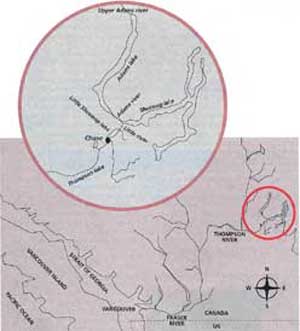Dry run
 the future of the sockeye salmon, which return every year to the Adams, one of North America's most important salmon rivers, remains uncertain despite efforts by the Canadian Federal government to cut the large commercial fishing fleet to half. The number of salmon returning to the river has dramatically decreased in recent years, with only 1.4 million sockeye expected to return in 1996 to the Fraser river, of which the Adams is a tributary. This will be the lowest number in 40 years, with overfishing, pollution and habitat degradation all playing a part.
the future of the sockeye salmon, which return every year to the Adams, one of North America's most important salmon rivers, remains uncertain despite efforts by the Canadian Federal government to cut the large commercial fishing fleet to half. The number of salmon returning to the river has dramatically decreased in recent years, with only 1.4 million sockeye expected to return in 1996 to the Fraser river, of which the Adams is a tributary. This will be the lowest number in 40 years, with overfishing, pollution and habitat degradation all playing a part.
The method by which salmon can return to the stream of their birth to spawn and die following years in the open ocean is not well understood. It has been shown that salmon have an extremely acute sense of smell, capable of distinguishing the scent of their home river, and yet more than smell is at work. Scientists believe that they can also detect the earth's magnetic field, and that awareness of changing day lengths helps to determine the timing of the salmon migration.
The Fraser in Canada and the Columbia in the us were historically two of the world's great salmon rivers. There may have been runs of up to 100 million fish in the Fraser before this century, supporting the natives whose culture was to a large extent based around the salmon. The Columbia, a large-volume river like the Fraser, once also had salmon runs of similar magnitude, supporting a strong fishing industry. However, extensive dam building since the '40s has caused such a decline in the numbers of salmon native to the Columbia and its tributaries that many are now on the us list of endangered species. As a result, many American fisherfolk have turned to the salmon returning to the Fraser river as they pass through American waters.
Fisherfolk have protested the Canadian government's plans to halve the fleet size, occupying the offices of the government department of fisheries and oceans in a number of Pacific coastal towns in May 1996. They say that the cuts will hurt small operators and leave commercial fishing licenses concentrated with a few large corporations, while providing inadequate training and compensation for fisherfolk who lose their livelihood.
Canadian government policy is influenced by the economic devastation experienced by Canada's Atlantic provinces following the collapse of fish stocks. The fishery there has now been closed to Canadian boats to allow stocks to recover, and an agreement reached with the European Union to prevent their boats from catching the last remnants. The agreement followed Canada's arrest of a Spanish fishing boat which was fishing with an illegal fine mesh net in the summer of 1995.
The David Suzuki Foundation, a Vancouver-based environmental group, says that the kinds of net used to fish for salmon have to be changed. In a report released following the unexpectedly small Adams river salmon run of 1994, the Foundation said that it is necessary to "greatly reduce or entirely eliminate the use of gill nets, one of the most destructive and wasteful fishing gears ever invented and the only gear that precludes live capture and selective release of fish.'
A clear blue-green river flowing from Adams lake in central British Columbia province, the Adams river supports a salmon run that is one of the most spectacular and economically important in the world. The young sockeye salmon are hatched in its gravel beds in the early summer before being swept downstream into Shuswap Lake. Covering some 30,000 ha, this large body of water acts as a nursery for the hatchlings for about a year, feeding on insects and acting as an important food source for trout. After a year, the salmon begin the journey through the Thompson and then the Fraser to the Pacific, where they spend three years before returning.
The salmon run on the Adams river is a four-year cycle, with the largest number of salmon returning in 1986, 1990, 1994, etc.
Related Content
- First food: business of taste
- Order of the National Green Tribunal regarding the deplorable condition of a water tank, Golconda Fort, Hyderabad, Telangana, 05/06/2025
- Order of the National Green Tribunal in the matter of Futala lake pollution, Nagpur, Maharashtra, 05/06/2025
- Order of the National Green Tribunal regarding large scale felling of toddy yielding palm trees in Bihar, 05/06/2025
- Order of the National Green Tribunal regarding deterioration of Nayar river, Uttarakhand, 05/06/2025
- Order of the National Green Tribunal regarding an illegal cracker unit in Thanjavur district, Tamil Nadu, 29/05/2025
